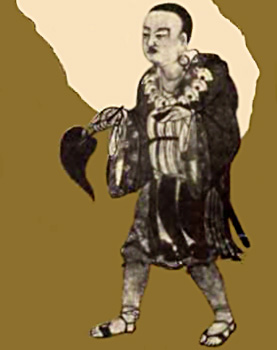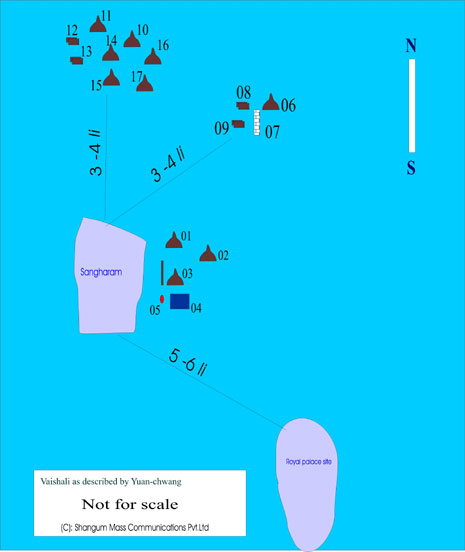|

Description of Vaishali

FEI-SHE-LI (Vaishali)
Introduction
This kingdom is about 5000 li in circuit. The soil is rich and fertile; flowers and fruits are produced in abundance. The Amra fruit (mango) and the mocha (banana) are very plentiful and much prized. The climate is agree-able and temperate. The manners of the people are pure and honest. They love religion and highly esteem learning. Both heretics and believers are found living together. There are several hundred sangharamas, which are mostly dilapidated. The three or five which still remain have but few priests in them. There are several tens of Deva temples, occupied by sectaries of different kinds. The followers of the Nirgranthas are very numerous.
The royal precincts
The capital city of Vaishali (or, called Vesali) is to a great extent in ruins. Its old foundations are from 60 to 70 li in circuit. The royal precincts are about 4 or 5 li round: there are a few people living in it.
A sangharama
North-west of the royal city (precincts) 5 or 6 li. is a sangharama with a few disciples. They study the teaching of the Little Vehicle, according to the Sammatiya school.
Stupa 01
By the side of it is a stupa. It was here Tathagata delivered the Vimalakirtti Sutra (Pi-mo-lo-kie-king) (विमलकीर्ति-सूत्र) and the son of a householder, Ratnakara, and others offered precious parasols (to Buddha).
Stupa 02
To the east of this is a stupa. It was here Sariputra and others obtained perfect exemption (became Arhats).
Stupa 03
To the south-east of this last spot is a stupa; this was built by a king of Vaisali. After the Nirvana of Buddha, a former king of this country obtained a portion of the relics of his body, and to honour them as highly as possible raised (this building).
The records of India state: In this stupa there was at first a quantity of relics equal to a “hoh” (ten pecks). Asoka-raja opening it, took away nine-tenths of the whole, leaving only one-tenth behind. Afterwards there was a king of the country who wished again to open the stupa, but at the moment when he began to do so, the earth trembled, and he dared not proceed to open (the stupa).
Stone pillar
To the north-west is a stupa built by Asoka-raja; by the side of it is a stone pillar about 50 or 60 feet high, with the figure of a lion on the top.
Markatahrada (मर्कट-ह्रद)
To the south of the stone pillar is a tank. This was dug by a band of monkeys (Markatahrada) for Buddha’s use. When he was in the world of old, Tathagata once and again dwelt here.
Stupa 04
Not far to the south of this tank is a stupa; it was here the monkeys, taking the alms-bowl of Tathagata, climbed a tree and gathered him some honey.
Stupa 05
Not far to the south is a stupa; this is the place where the monkeys offered the honey to Buddha. At the north-west angle of the lake there is still a figure of a monkey.
The sangharama, Vimalakirti’s house
To the north-east of the sangharama 3 or 4 li is a stupa; this is the old site of the house of Vimalakirtti (Pi-mo-lo-ki); various spiritual signs (manifestations) are exhibited here.
A pile of bricks
Not far from this is a spirit-dwelling (a chapel.?), its shape like a pile of bricks. Tradition says 77 this stone-pile is where the householder Vimalaklrtti preached the law when he was sick.
Stupa 06
Not far from this is a stupa; this is the site of the old residence of Ratnakara (P’ao’tsi). (रत्नाकर)
Stupa 07
Not far from this is a stupa; this is the old house of the lady Amra. 79 It was here the aunt of Buddha and other Bhikshunis obtained Nirvana:
To the north of the sangharama 3 or 4 li is a stupa; this indicates the place where Tathagata stopped when about to advance to Kusinagara to die, whilst men and Kinnaras followed him. From this not far to the north-west is a stupa; here Buddha for the very last time gazed upon the city of Vaishali. Not far to the south of this is a vihara, before which is built a stupa; this is the site of the garden of the Amra-pali, which she gave in charity to Buddha.
Stupa 08
By the side of this garden is a stupa; this is the place where Tathagata announced his death. When Buddha formerly dwelt in this place, he told Ananda as follows:
-”Those who obtain the four spiritual faculties are able to extend their lives to a kalpa. What is the term of years of Tathagata then? “
Thrice he asked this question, and Ananda answered not, through the fascination of Mara. Then Ananda rising from his seat gave himself up to silent thought in a wood. At this time Mara coming to Buddha, asked him, saying,
“Tathagata has for a long time dwelt in the world teaching and converting. Those whom he has saved from the circling streams (of transmigration) are as numerous as the dust or the sands. This surely is the time to partake of the joy of Nirvana.”
Tathagata taking some grains of dust on his nail, asked Mara, saying, “ Are the grains of dust on my nail equal to the dust of the whole earth or not? “
He answered,
“The dust of the earth is much greater.” Buddha said,
“Those who are saved are as the grains of earth on my nail ; those not saved like the grains of the whole earth ; but after three months I shall die.”
Mara hearing it was rejoiced and departed.
Meantime Ananda in the wood suddenly had a strange dream, and coming to Buddha he told it to him, saying, “I was in the wood, when I beheld in my dream a large tree, whose branches and leaves in their luxuriance cast a grateful shade beneath, when suddenly a mighty wind arose which destroyed and scattered the tree and its branches without leaving a mark behind. Oh, forbid it that the lord is going to die! My heart is sad and worn, therefore I have come to ask you if it be so or not? “
Buddha answered Ananda,
“I asked you before, and the head-turban of Buddha after the incursion of these people into India great renunciation ; he is fitly placed than is generally allowed, the date above that heaven as being the “ lord of the Southern books of Buddh of the world of desire,” and therefore ism (the book of the Great Decease always described as occupying the and others), which contain accounts upper mansion of this tier of heavens, respecting the character, habits, and His distress and rage are indicative dress of the Lichhavis (which corre. of his condition of mind in know spend with the Northern accounts), ledge of Bodhisattva’s renunciation, must be brought down considerably If the four identifications on this later than the assumed date of the re-pillar are correct, we may conclude diction of the Pali canon. But, on that the people of Vais’ali were at the other hand, if it be true that the Northern people allied to the Yue- incursion of these people took place chi, which illustrates the observa- when Pataliputra was strengthened.
Mara so fascinated you that you did not then ask me to remain in the world. Mara-raja has urged me to die soon, and I have covenanted to do so, and fixed the time. This is the meaning of your dream.”
Stupa 09
Not far from this spot is a stupa. This is the spot where the thousand sons beheld their father and their mother.
Formerly there was a Rishi who lived a secret life amid the crags and valleys. In the second month of spring he had been bathing himself in a pure stream of water. A roe deer which came to drink there just after, conceived and brought forth a female child, very beautiful beyond human measure, but she had the feet of a deer. The Rishi having seen it adopted and cherished it (as his child).
As time went on, on one occasion he ordered her to go and seek some fire. In so doing she came to the hut of another Rishi; but wherever her feet trod there she left the impression of a lotus-flower on the ground. The other Rishi having seen this, was very much surprised, and bade her walk round his hut and he would give her some fire. Having done so and got the fire, she returned. At this time Fan-yu-wang (Brahmadatta raja )(ब्रह्मदत्त राजा) going out on a short excursion, saw the lotus-flower traces, and followed them to seek (the cause). Admiring her strange and wonderful appearance, he took her back in his carriage. The soothsayers casting her fortune said,
“She will bear a thousand sons.”
Hearing this, the other women did nothing but scheme against her. Her time having been accomplished, she brought forth a lotus-flower of a thousand leaves, and on each leaf was seated a boy. The other women slandered her on its account, and saying it was “an unlucky women,” threw (the lotus) into the Ganges, and it was carried away by the current.
The king of Ujiyana (U-shi-yen) (उज्जैन), down the stream going out for an excursion, observed a yellow-cloud-covered box floating on the water and coming towards him. He took it and opened it, and there saw a thousand boys; being well nourished, when they came to perfect stature, they were of great strength. Eelying on these, he ex tended his kingdom in every direction, and encouraged by the victories of his troops, he was on the point of extending his conquests to this country (i.e., Vaishali).
Brahmadatta-raja hearing of it, was much alarmed; fearing his army was not able to contend successfully with the invaders, he was at a loss what to do. At this time the deer-footed girl, knowing in her heart that these were her sons, addressed the king thus:
“Now that these youthful warriors are approaching the frontier, from the highest to the lowest there is an absence of courage (heart). Your feeble wife by her thought is able to conquer those redoubtable champions.”
The king not yet believing her remained overwhelmed with fear. Then the deer-girl, mounting the city wall, awaited the arrival of the warriors. The thousand youths having surrounded the city with their soldiers, the deer-girl said to them,
“Do not be rebellious! I am your mother; you are my sons.”
The thousand youths replied,
“What extravagant words are these?”
The deer-girl then pressing both her breasts, a thousand jets of milk flowed out therefrom, and by divine direction fell into their mouths. Then they laid aside their armour, broke their ranks, and returned to their tribe and family. The two countries mutually rejoiced, and the people rested in peace.
Stupa 10
Not far from this spot is a stupa. This is where Tathagata walked for exercise, and left the traces thereof. In teaching (or, pointing to the traces) he addressed the congregation thus:
“In ancient days, in this place, I returned to my family on seeing my mother. If you would know then, those thousand youths are the same as the thousand Buddhas of this Bhadra-kalpa.”
Stupa 11
To the east of the spot where Buddha explained this birth (jataka) is a ruined foundation above which is built a stupa. A bright light is from time to time reflected here. Those who ask (pray] in worship obtain their requests. The ruins of the turreted preaching-hall, where Buddha uttered the Samantamukha, dhdrani and other sutras, are still visible.
Stupa 12
By the side of the preaching-hall, and not far from it, is a stupa which contains the relics of the half body of Ananda.
Several stupas
No far from this are several stupas the exact number has not yet been determined. Here a thousand Pratyeka Buddhas (To-kio) attained Nirvana, Both within and without the city of Vaishali, and all round it, the sacred vestiges are so numerous that it would be difficult to recount them all. At every step commanding sites and old foundations are seen, which the succession of seasons and lapse of years have entirely destroyed. The forests are uprooted; the shallow lakes are dried up and stinking; nought but offensive remnants of decay can be recorded.
|
|
 |
|
